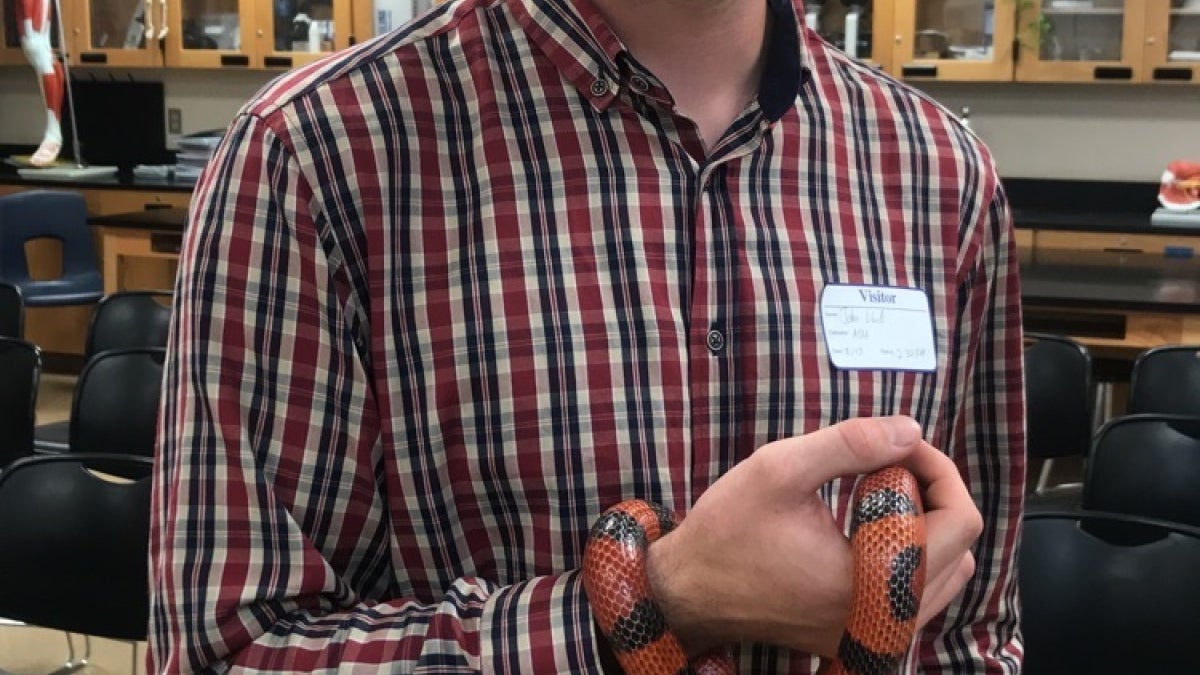ASU grad student earns fellowship from National Science Foundation

Doctoral student John Vant from the School of Molecular Sciences and the Biodesign Institute’s Center for Applied Structural Discovery.
John Vant, a graduate student at Arizona State University’s School of Molecular Sciences and the Biodesign Institute’s Center for Applied Structural Discovery, was recently awarded a National Science Foundation Graduate Research Fellowship and the LeRoy Eyring Memorial Fellowship.
That's even more impressive considering Vant said that attending graduate school was, for him, “a low probability phenomenon” and “not for kids like me.”
Growing up, Vant always had a passion for investigation, which was often simply interpreted by teachers as “disruptive” behavior, leading to separation from the rest of the class. Ultimately John says he owes a great deal of gratitude to his family and mentors for helping him realize his potential.
The National Science Foundation Graduate Research Fellowship Program recognizes and supports outstanding graduate students in NSF-supported science, technology, engineering and mathematics disciplines. NSF fellows typically become globally engaged knowledge experts and leaders who contribute significantly to research, education and innovations in science and engineering. Fellows are selected by a national competition from a pool of 12,000-16,000 applicants from across the United States and its territories. Success rates for NSF-GRFP applicants range from about 12.5%-16.5% over the last five years.
As the oldest graduate fellowship of its kind, the GRFP has a long history of selecting recipients who achieve high levels of success in their future academic and professional careers. The reputation of the GRFP follows recipients and often helps them become lifelong leaders who contribute significantly to both scientific innovation and teaching. Past fellows include numerous Nobel Prize winners, U.S. Secretary of Energy Steven Chu, Google founder Sergey Brin and "Freakonomics" co-author Steven Levitt.
The LeRoy Eyring Memorial Fellowship is named after LeRoy Eyring, an ASU Regents Professor of chemistry and department chair whose instructional and research accomplishments and professional leadership at ASU helped to bring the department of chemistry and biochemistry into international prominence.
“John is an excellent student and a great colleague," said Assistant Professor Abhishek Singharoy, Vant’s doctoral adviser. "His work integrates novel method developments in protein biophysics with state-of-the-art applications in bioenergy. His growth reflects very strongly on the intellectual credibility that (the School of Molecular Sciences) and ASU have achieved!”
Vant’s research focuses on discovering the molecular underpinnings of biological behavior. He does this by utilizing molecular dynamics simulations as a computational microscope, which helps him probe the nature of protein dynamics.
"I am tremendously honored to receive these awards and I believe this is a reflection of the strong academic environment cultivated by the School of Molecular Sciences," said Vant.
On top of his awards Vant also recently published online a first author paper (his first) in the Journal of Chemical Information and Modeling titled "Flexible Fitting of Small Molecules into Electron Microscopy Maps using Molecular Dynamics Simulations with Neural Network Potentials."
This work seeks to complement cryo-electron microscopy (EM) efforts for use as a drug-discovery tool. Vant, Singharoy and their colleagues have built a computational pipeline which combines high-level quantum chemistry calculations and flexible fitting protocols to resolve protein-ligand coordinations. The pipeline was found to improve quality metrics of published protein-ligand structures for three unique examples.
More Science and technology

Lucy's lasting legacy: Donald Johanson reflects on the discovery of a lifetime
Fifty years ago, in the dusty hills of Hadar, Ethiopia, a young paleoanthropologist, Donald Johanson, discovered what would…

ASU and Deca Technologies selected to lead $100M SHIELD USA project to strengthen U.S. semiconductor packaging capabilities
The National Institute of Standards and Technology — part of the U.S. Department of Commerce — announced today that it plans to…

From food crops to cancer clinics: Lessons in extermination resistance
Just as crop-devouring insects evolve to resist pesticides, cancer cells can increase their lethality by developing resistance to…